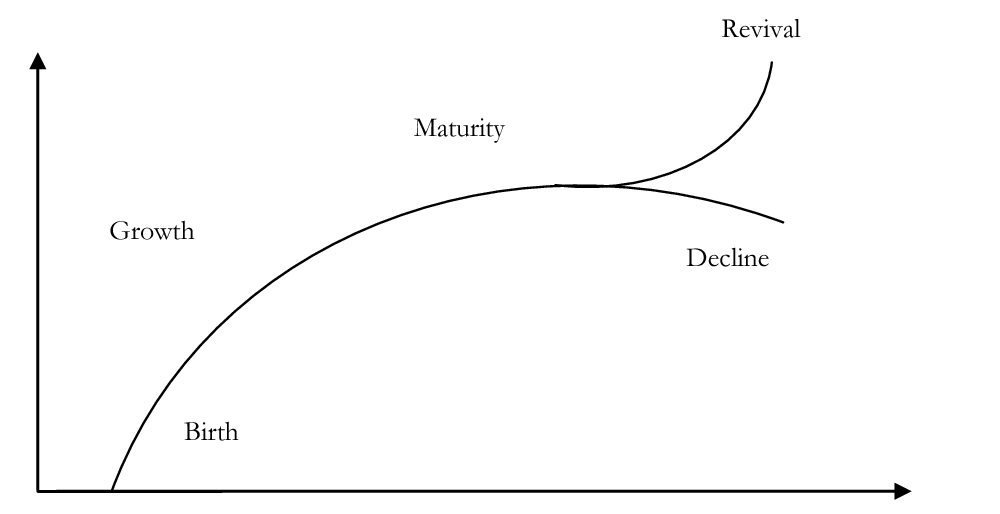
Every organization goes through different phases; an organizational life cycle divided into the following phases:
- Existence / Start-up (or Birth): Early days of the company.
- Survival: Organizations try to expand their business (try to achieve growth)
- Maturity phase: Company reaches the peak from where it becomes difficult to grow further.
- Renewal Phase: Companies may reinvent / renew itself to give it another chance at growth.
Organizational Decline: Every company enter the decline phase, eventually resulting in the shutdown of the company.
Like an individual, an organisation is perceived to go through a ‘lifecycle’, experiencing various stages of birth, maturity, and death. The organisational lifecycle states that as an organisation develops, it not only grows in terms of size, but it also ‘matures’ in various aspects (Daft et al.,2010).
Phelps, Adams and Bessant (2007, p.1) identify several assumptions underpinning the lifecycle theory – ‘growth is linear, sequential, deterministic and invariant. However, with passing years, these assumptions have slowly become less valid due to the rapidly growing environment that forces firms to adopt greater degree of flexibility and adaptation.
Several authors have described the lifecycle to consist of different stages. Robert E. Quinn and Kim Cameron (1983) have identified nine models of the organisational lifecycle given by different authors. Using these as a basis, Quinn and Cameron (1983) present an integrated model consisting of four stages.
The first stage is called the entrepreneurial stage. This stage is characterized by a high degree of innovation, creativity and originality (Quinn and Cameron, 1983). The main driving force is the vision, motivation and determination of the founder, who is solely responsible for decision-making. Moreover, the organisation has an informal and non-bureaucratic structure, wherein communication is free-flowing with very little planning and coordination. The goal of the firm is survival, as it strives to create both a product and market for itself. This stage continues until the company grows, forcing the owner to realize the need for a formal structure.
A ‘crisis of leadership’ (Daft et al., 2010; see also Greiner 1998) arises, wherein greater coordination and formalization is required to manage the growing number of employees, along with effective delegation of roles. Employment of knowledgeable managers and adoption of efficient practices helps the firm overcome the crisis and enter the next stage of the lifecycle.
The second stage is the ‘collectivity stage’. This stage is characterized by high cohesion and commitment among employees, as a sense of collectivity prevails (Quinn and Cameron, 1983). Formalization introduced to overcome the previous crisis enables the adoption of some procedures, formation of departments, along with a hierarchy of authority and division of labor (Daft et al., 2010). However, this structural adoption is slow due to the owner’s resistance to delegate. This gives rise to the ‘crisis of autonomy’ (Greiner, 1998), whereby a system of centralization gets established. Lower level employees do not have decision-making power, leading to lack of motivation at the shop-floor level.
The third stage is characterized by monumental changes, and is identified as the formalization and control stage. It is described as the ‘youth’ of the firm by Lippitt and Schmidt (1967). In this stage, greater emphasis is laid on formalization of rules and procedures, along with the establishment of a stable structure. There is existence of a formal communication structure (Greiner, 1998). According to Greiner, a functional structure is introduced with the purpose of creating separate, specialized activity areas. This increases the overall efficiency of the firm. However, this rigid hierarchy soon results in depletion of innovation and leads to the ‘crisis of red-tape’ and bureaucracy in the firm (Daft et al., 2010). Need for a proper balance between formal and informal systems is, thus, felt.
The fourth and final stage aims to deal with the red tape crisis by focusing on collaboration. It is termed as the ‘elaboration stage’, wherein efforts are made to reignite the creativity and innovation of the youthful firm, with a more flexible communication system, while simultaneously achieving the efficiency associated with the mature firm (Daft et al., 2010). As stated by Greiner (1998), ‘social control and self-discipline replace formal control.’
He also suggests the adoption of dual organisational structures: ‘a habit structure for getting the daily work done and a reflective structure for stimulating new perspectives and personal enrichment.’
The structure changes with the progression in lifecycle stages. Therefore, it becomes necessary to determine how, if at all, the organisation structure relates with the lifecycle of the organisation.
BATheories.com is managed by a group of educators from Mumbai. We also manage the website StudyMumbai.com. Our panel includes experienced professionals and lecturers with a background in management. BATheories is where we talk about the various business theories and models for BA (Business Administration) students.